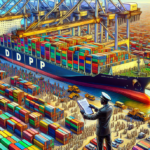Understanding the Difference Between DAP and DDP
In the realm of international trade, understanding the nuances of shipping terms is crucial for optimizing supply chain operations. Two commonly used Incoterms are Delivered at Place (DAP) and Delivered Duty Paid (DDP). While they may appear similar, they delineate distinct responsibilities and costs between buyers and sellers. This article provides an in-depth analysis of DAP and DDP, highlighting their differences, advantages, and considerations for businesses.
Introduction to DAP and DDP
Incoterms, short for International Commercial Terms, are standardized trade terms published by the International Chamber of Commerce (ICC) that define the responsibilities of buyers and sellers in international transactions. Understanding DAP and DDP is essential for businesses engaged in cross-border trade to mitigate risks and manage costs effectively.
What is Delivered at Place (DAP)?
Delivered at Place (DAP) is an Incoterm where the seller is responsible for delivering the goods to a specified destination. The seller manages packing, loading, and transportation costs up to the agreed-upon location. However, the buyer assumes responsibility for unloading the goods and handling any import duties or taxes. This arrangement provides the buyer with greater control over the final leg of the delivery process.
What is Delivered Duty Paid (DDP)?
Delivered Duty Paid (DDP) represents the most comprehensive obligation for the seller. In a DDP agreement, the seller handles all aspects of the shipping process, including export and import duties, taxes, and any other charges related to transporting the goods to the buyer's location. This term offers maximum convenience for the buyer, as the seller assumes full responsibility for the delivery.
Key Differences Between DAP and DDP
While both DAP and DDP involve the seller delivering goods to a specified location, the primary differences lie in the allocation of responsibilities and costs related to customs clearance and import duties.
Responsibilities and Cost Allocation
- DAP: Seller covers transportation costs up to the destination. Buyer handles unloading and import duties.
- DDP: Seller manages all costs, including transportation, unloading, and import duties.
Risk Management
Under DAP, the buyer assumes risk once the goods arrive at the destination. In contrast, DDP places the risk on the seller until the goods are delivered and responsibilities fully transfer to the buyer.
Advantages and Disadvantages
Advantages of DAP
- Greater Control for Buyers: Buyers can choose their own customs brokers and manage the import process according to their preferences.
- Potential Cost Savings: Buyers may save on import duties and taxes by managing the clearance process themselves.
Disadvantages of DAP
- Complexity for Buyers: Buyers must navigate the import process, which can be challenging in countries with stringent regulations.
- Risk of Additional Costs: Unexpected import fees or delays can lead to increased costs and extended delivery times.
Advantages of DDP
- Convenience for Buyers: Sellers handle all aspects of shipping, reducing the administrative burden on buyers.
- Predictable Costs: Buyers know the total cost upfront, as all duties and taxes are included.
Disadvantages of DDP
- Higher Costs for Sellers: Sellers bear the responsibility and cost of import duties and taxes, which may be reflected in higher prices.
- Limited Control for Buyers: Buyers have less influence over the import process and may rely solely on the seller's handling.
Choosing Between DAP and DDP
Selecting the appropriate Incoterm depends on various factors, including the nature of the goods, the destination country's regulations, and the buyer's logistical capabilities.
Factors to Consider
- Experience with Import Procedures: Buyers familiar with customs processes may prefer DAP, while those less experienced might opt for DDP.
- Control Over Logistics: Businesses seeking greater control over the final delivery stages may find DAP more suitable.
- Cost Management: If predictable pricing is essential, DDP can offer clarity by including all duties and taxes.
Case Study: Large Retailers vs. Small Businesses
Major retailers like Amazon and Walmart often utilize DDP to streamline their international shipping processes, ensuring a seamless customer experience. Conversely, smaller businesses or niche manufacturers might employ DAP to maintain control over their supply chains and optimize costs.
Best Practices for Implementing DAP or DDP
To effectively utilize DAP or DDP, businesses should adhere to best practices that ensure smooth logistics operations and compliance with international regulations.
Effective Communication and Documentation
Clear communication between buyers and sellers is essential. Detailed documentation should outline each party's responsibilities, including shipping schedules, handling procedures, and contact information for logistics partners.
Partnering with Reliable Logistics Providers
Collaborating with experienced carriers and customs brokers can mitigate risks associated with international shipping. Reliable partners can navigate complex customs regulations and ensure timely deliveries.
Implementing Robust Tracking Systems
Utilizing advanced tracking technologies allows both buyers and sellers to monitor shipments in real-time, providing transparency and enabling proactive management of any issues that arise during transit.
Future Trends in Logistics: Impact on DAP and DDP
The logistics industry is continually evolving, influenced by technological advancements and shifting global trade dynamics. Emerging trends are poised to impact the use of DAP and DDP in significant ways.
Automation and Data Analytics
Increased automation and the use of data analytics in logistics can enhance the efficiency of both DAP and DDP processes. Predictive analytics can optimize routing, while automation can streamline documentation and clearance procedures.
Sustainability Initiatives
As businesses prioritize sustainability, the choice between DAP and DDP may be influenced by the environmental impact of shipping practices. Sustainable packaging and optimized transport routes can align with corporate social responsibility goals.
Changing Trade Regulations
Global trade policies and regulations are subject to change, which can affect the feasibility and attractiveness of DAP and DDP agreements. Staying informed about regulatory developments is crucial for maintaining compliance and operational continuity.
Conclusion
Choosing between Delivered at Place (DAP) and Delivered Duty Paid (DDP) hinges on a business's specific needs, capabilities, and strategic goals. While DAP offers greater control and potential cost savings for experienced buyers, DDP provides convenience and predictability by shifting the majority of responsibilities to the seller. By carefully evaluating these factors and implementing best practices, businesses can effectively manage international shipments, enhance supply chain efficiency, and expand their global reach.




















